Archived Water Damage Blog Posts
Monitoring Your House for Water Damage
3/18/2022 (Permalink)
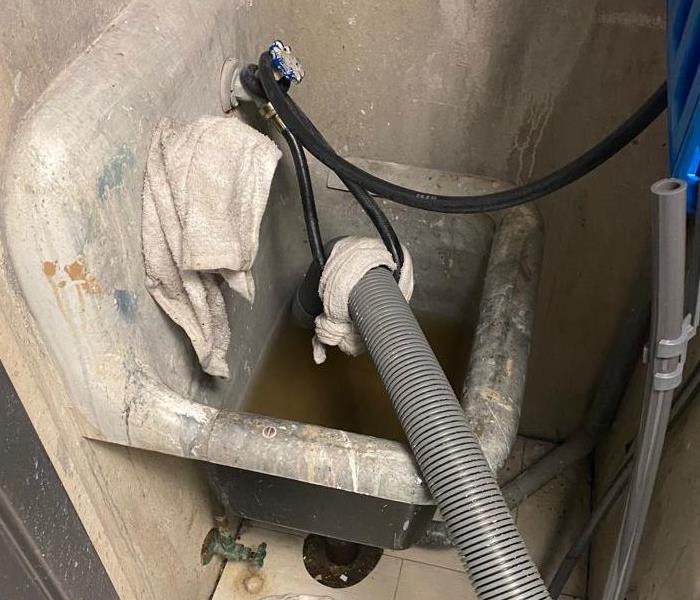 Negligence led to this sink flooding and damaging the floor below.
Negligence led to this sink flooding and damaging the floor below.
Question
How can one watch out for water damage? What is the purpose of monitoring a home?
Water Damage Clues
There are many clues that can give away a future water damage situation requiring remediation.
- Wet floor
- Paint peeling/pulling
- Black spots appearing on surfaces
- Moist, musty smell
- Wet couches, carpets, or other items
- Utility bill increases unnecessarily
- Leaks
- Strange sounds like drips
Watching out for more than one of these is important as water damage rarely comes to light until it's festered a while.
Monitoring Your Home
Monitoring can prevent a future water damage or detect it before it causes more harm.
Luckily, some vigilance and work is all it takes to keep on track and prevent this issue. Appliances are a large water and fire risk if not maintained properly. A quick check of the floors and walls during routine cleaning increases one's chance of finding water spots. Having a baseline water bill gives an average amount which can be used to detect irregularities in one's water system. Monitoring does not have to be a complicated process; a simple system that allows one to detect odd spots, smells, and sounds is enough.
This will give you the edge on a crisis before it wreaks havoc on your home.
Water Damage Tips!
4/6/2021 (Permalink)
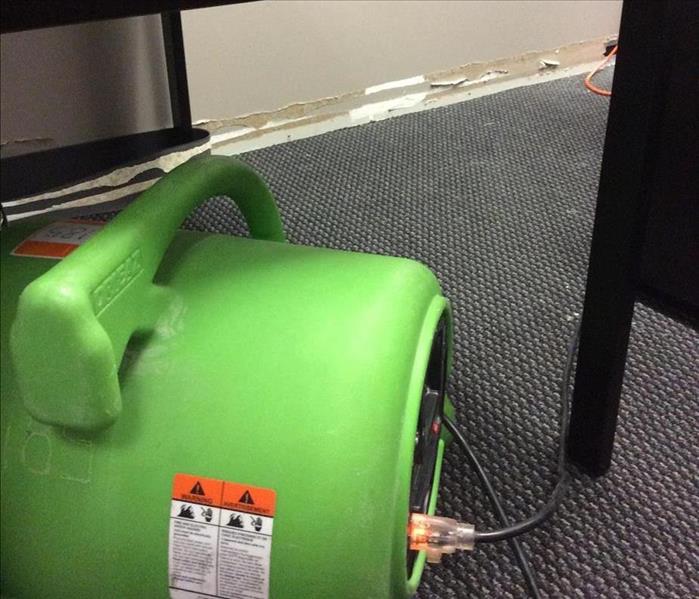 Water Damage drying with air blower
Water Damage drying with air blower
Call SERVPRO of Wynwood today at (305) 377-2325!
Summary: SERVPRO of Wynwood stresses the importance of prioritizing safety when dealing with a water damage emergency.
When a home or business owner is confronted with a large-scale water damage incident, it is vital to prioritize the safety of families, employees, customers, and other individuals. SERVPRO of Wynwood is sharing 7 safety tips to help people navigate the aftermath of a water damage emergency. These safety tips are applicable for residential or commercial water damage that is internally sourced from a leaky faucet, a cracked water pipe, or a broken water heater. Water damage resulting from a natural disaster such as a flood, tornado, or hurricane has a set of issues that go beyond the extent of an internally sourced water damage situation.
Tip #1: Stay calm. Do not panic.
Water damage to a home or business is stressful, especially if the water damages expensive furniture, ruins family heirlooms, destroys valuable inventory, or requires the property to be evacuated for a period of days or even weeks. Trained, experienced professionals take care of water damage emergencies every day, and they eliminate a large portion of the stress and anxiety. Skilled restoration experts do a thorough job in a timely fashion, so people do not have to worry.
Tip #2: Identify and eliminate electrical hazards.
A flooded house presents a challenge to the homeowner. Floor covering can be replaced, upholstery can be cleaned, and baseboards can be repainted. Electrocution, however, can be fatal.
The first concern is always personal safety, even before identifying the source of the flooding and shutting off the water. If the flooding is extensive, electrical shock is always a concern. Avoid stepping in the water until sources of potential electrical shock have been identified and resolved. Appliances and extension cords in the water are particularly dangerous. Be safe. Shut off the power from outside the home or commercial building. A water damage issue could turn into a fire hazard if electrical appliances are exposed to water.
Tip #3: Identify any chemical or sanitation hazards before entering the residence or building.
Strong smells, burning and itching eyes, or skin irritation may be indicators that the water may have come into contact with activated chemicals. Carefully do a smell test. Is the liquid on the floor more than water? Is it contaminated with raw sewage? It is unsanitary to track raw sewage throughout the entire house in the search for the water leak. What may have been a relatively simple clean up could be expanded to include the whole house.
Tip #4: Avoid slipping and falling.
Watch out for slippery surfaces. Wet floors can be exceedingly slippery, so hold on to cabinets or furniture when walking on slick kitchen or bathroom floors. Wear shoes or boots that provide stability and reduce the possibility of slipping and falling. It is better to keep shoes on while walking through the flooded areas to prevent slipping and to protect the feet from injury.
Tip #5: Use a flashlight when walking through areas that are dark or dimly lit.
If the flooding was so extensive that the electricity needed to be turned off, use a flashlight to illuminate the home. Proper lighting improves balance and stability. Groping around in the dark can lead to head and hand injuries. Further safety hazards can be created if furniture is turned over or glass is broken.
Tip #6: Wear rubber gloves and other protective clothing, if possible.
Wearing rubber gloves, protective eyewear, sturdy shoes or boots, and a mask or respirator are advisable if at all possible. If the leak has persisted over an extended period of time, mold, mildew, and bacteria may have had time to grow. Mold exposure can cause health effects. Also, the liquid on the floor and carpet may be contaminated with raw sewage. Chemicals may have mixed with the water and may have become activated, toxifying the air and the water. Any exposure to these contaminants could be hazardous or even deadly.
Tip #7: Avoid lifting heavy items.
Water-logged pillows, cushions, clothing, carpet, and padding are very heavy. Be careful walking across slippery surfaces. Carrying a heavy load or slipping unexpectedly can wrench the back or cause other injuries.
If the situation is severe and the environment is hazardous, the safest course of action may be to shut off the electricity and water, call the water damage specialists, and wait. Each crisis is unique and carries its own set of safety hazards. Immediate response from a water damage specialist is essential because much of the damage is done in the first few hours of the incident. Getting a trained technician with the best equipment on the scene as soon as possible is always a best-case scenario in a worst-case situation.
Kitchen Appliance Maintenance
3/24/2021 (Permalink)
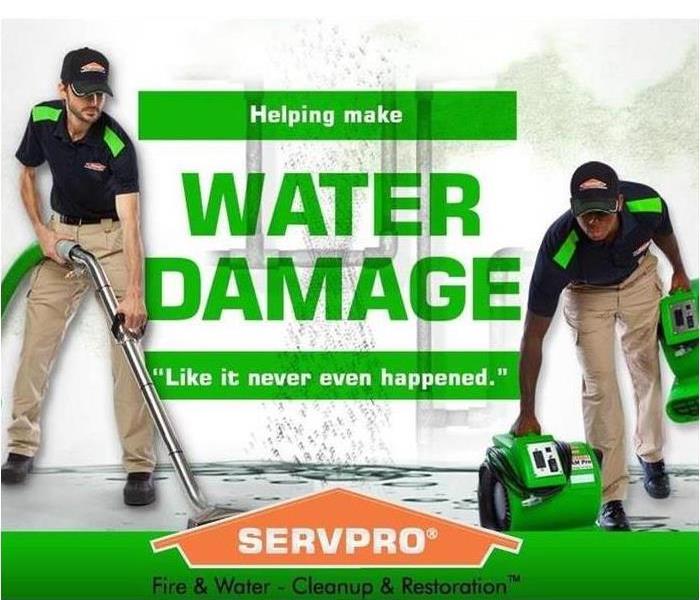 SERVPRO Technicians vacuuming water flood
SERVPRO Technicians vacuuming water flood
SERVPRO of Wynwood is faster to any size disaster!
Some of the home floods commonly occur in the kitchen due to its many water outlets. For most homes, the kitchen commonly incorporates multiple appliances that connect to a water supply line. It is important to understand that water damages that occur in the kitchen may possibly spread past the kitchen and create larger damages throughout one's home. Keep your home prepared by periodically checking the appliances to help reduce water damage incidents from occurring. However, a few common items that may lead to a kitchen flood are as follows:
Dishwasher
Over time, the water supply line in a dishwasher may degrade. This can lead to water leaking into enclosed areas under the appliance and rupture entirely. Check this line twice a year by removing the kick plate at the front of the dishwasher and use a flashlight to inspect the space and surrounding areas. If the area is wet with no explanation, this should be taken as a red flag. The dishwasher water supply line shut off should be located under the kitchen sink; turn it off and call a plumber.
Under Sink System
Underneath the sink, you may find a water filtration system. As time passes, the lines can degrade and rupture. A crack in the line can lead to flooding and potentially much worse. Check the sink twice a year to avoid any costly damages.
Refrigerator
Moving the refrigerator may be tricky sometimes. It's important to be cautious about its placement. Moving the refrigerator too close to the wall may kink or break the water supply line. However, having the refrigerator too far out may cause potential over-stress on the line and potentially cause the line to rupture. Keep in mind, the plastic water supply line degrades over time and can crack or break. To prevent water damages from potentially happening, it is advisable to remove the plastic line and replace it with a copper or stainless-steel line that has better durability.
Being prepared can help prevent a disastrous situation. By regularly checking on these appliances, you will help avoid any catastrophic damages. SERVPRO of Wynwood is faster to any sized disaster, and we are here to help 24/7/365 to make it "Like it never even happened."
5 Facts About Commercial Water Damage
3/1/2021 (Permalink)
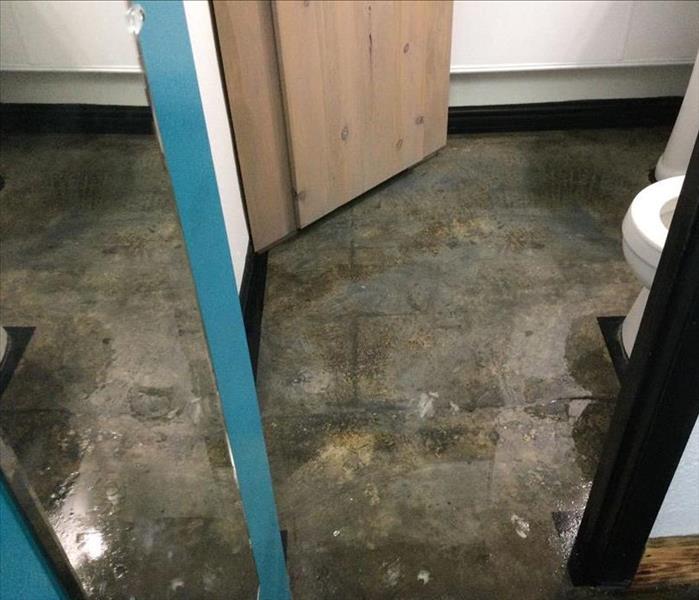 Water Damage Bare Floor
Water Damage Bare Floor
Commercial water damage in Wynwood, FL.
Facts About Commercial Water Damage
Every building is in danger of water damage. Whether it comes from a broken pipe or roof leak, it can cause serious damage to your business. Here are a few facts business owners should know about commercial water damage.
1. Regular Maintenance Can Stop Damage
Regularly inspect your building for problems. This includes checking for a clogged gutter, roof damage, and broken pipe. You may even want to have a professional come out and examine your building yearly.
2. Leaking Roofs Cause Problems
A tiny leak in your roof can cause more damage than a broken pipe. Even buildings with new roofs can leak due to freezing temperatures, high winds, and hail.
3. There Are 3 Different Categories of Water Damage
There are 3 different categories of water, including clean, black, and grey water. What is necessary to clean the damage up and the safety precautions used is based on the water category. Therefore, it is a good idea to have water restoration professionals clean up the damage.
4. Insurance Doesn’t Cover All Damage
Most insurance companies cover unexpected water damage if it comes from within your building in Wynwood, FL. Typically, they don't cover floodwaters that occur due to natural disasters. For this reason, you should read your insurance policy and make sure it offers the coverage you want.
5. Flood Insurance Policies Are Available
There are insurance policies available specifically for flood zones. If your business is in an area with a high risk of flooding, purchase a flood policy. You can have this coverage added to your standard policy, or you can purchase a separate one from a different insurance company.
Water damage can strike at any minute. Therefore, it is important to know a little about this and the water repair process. It is also important to know what your insurance covers and if you need an extra policy. This can help protect your business from water damage.
Servicing A Water Damage Incident
2/9/2021 (Permalink)
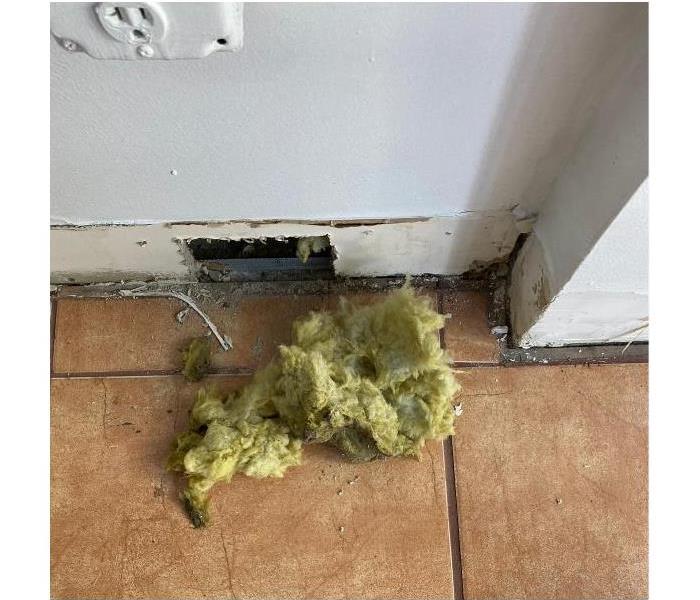 Water damage to drywall and insulation
Water damage to drywall and insulation
Flooding and water emergencies don’t wait for regular business hours and neither do we. SERVPRO of Wynwood provides emergency cleaning and restoration services 24 hours a day, 7 days a week—including all holidays.
“Faster to any size disaster.”
Flooding and water damage are very invasive. Water quickly spreads throughout your home and gets absorbed into floors, walls, furniture, and more. SERVPRO of Wynwood arrives quickly and starts the water extraction process almost immediately. This immediate response helps to minimize the damage and the cleaning and restoration costs.
Need Emergency Service? Call Us 24/7 – (305) 377-2325
Water Damage Timeline
Within Minutes
- Water quickly spreads throughout your property, saturating everything in its path.
- Water is absorbed into walls, floors, upholstery, and belongings.
- Furniture finishes may bleed, causing permanent staining on carpets.
- Photographs, books, and other paper goods start to swell and warp.
Hours 1 - 24:
- Drywall begins to swell and break down.
- Metal surfaces begin to tarnish.
- Furniture begins to swell and crack.
- Dyes and inks from cloth and paper goods spread and stain.
- A musty odor appears.
48 Hours to 1 Week:
- Mold and mildew may grow and spread.
- Doors, windows, and studs swell and warp.
- Metal begins to rust and corrode.
- Furniture warps and shows signs of mold.
- Paint begins to blister.
- Wood flooring swells and warps.
- Serious biohazard contamination is possible.
More Than 1 Week:
- Restoration time and cost increase dramatically; replacing contaminated materials and structural rebuilding may be extensive.
- Structural safety, mold growth, and biohazard contaminants pose serious risks to occupants.
About SERVPRO of Bellaire
SERVPRO of Wynwood specializes in the cleanup and restoration of residential and commercial property after a fire, smoke or water damage event. Our staff is highly trained in property damage restoration. From initial and ongoing training at SERVPRO’s corporate training facility to regular IICRC-industry
How To Spot Potential Water Damage Causes
1/31/2021 (Permalink)
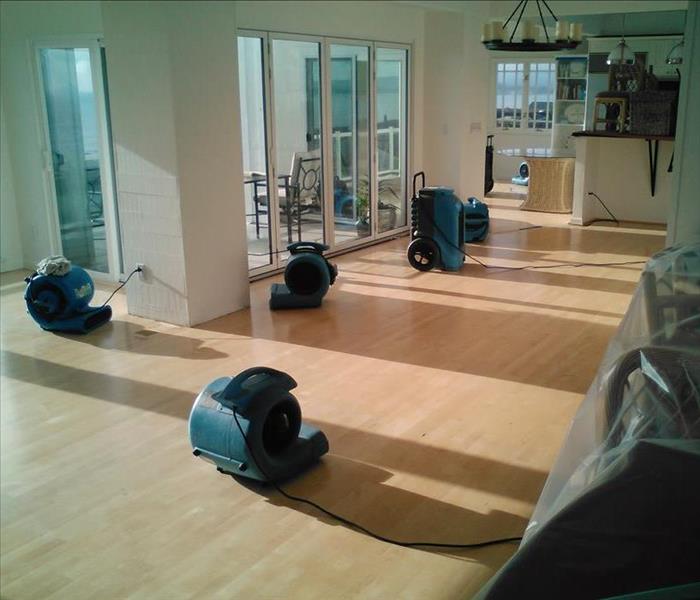 Livingroom with Air Blowers Drying water Damage
Livingroom with Air Blowers Drying water Damage
Catching water damage before it becomes evident can save you time and money, so knowing the top spots in your home to regularly monitor for damage is crucial for any homeowner. Instead of waiting until a water stain appears on your ceiling or water pools on the floor under your sink, make it a priority to inspect these three spots for water damage on a monthly basis.
- Check under the sink.
Sinks are regularly located in your kitchen, your bathrooms, and maybe even in other rooms in your house. Since water flows from the faucets and comes up through pipes underneath the sink, it’s not uncommon for leaky sinks to occur. Always inspect the cabinetry and piping underneath your sink for any leaks or moisture.
- Don’t forget to look behind the toilet.
Your toilet is another frequently-used appliance in your home that uses a lot of water with every flush. Monitoring the space behind and around your toilet for any water damage is always a good practice.
- Take a look at your roof.
It’s easy to forget to look at your roof for water damage, but if your gutters aren’t working properly or your roof isn’t in good shape, there’s a fair chance that water may be seeping through your roof into your attic, your garage, and your ceilings. It can be hard to know what to look for, but any obvious water stains are a bad sign. Be sure to check out the roof from the exterior and the interior sides (your ceilings).
Water damage can be costly and affect the structural integrity of your home, and so it’s important to keep an eye out for water damage before it wreaks havoc. If you’re looking to buy a new home, here are a few things to look for to ensure that you don’t prematurely buy a home that’s susceptible to water damage.
If you recognize the signs of water damage on one of your regular rounds inspecting the vulnerable areas of your home, contact SERVPRO of Wynwood at 305-377-2325. With state-of-the-art technology and training, our disaster restoration professionals are equipped for handling the job
How To Determine If Your Water Damage Is Covered By Insurance
1/25/2021 (Permalink)
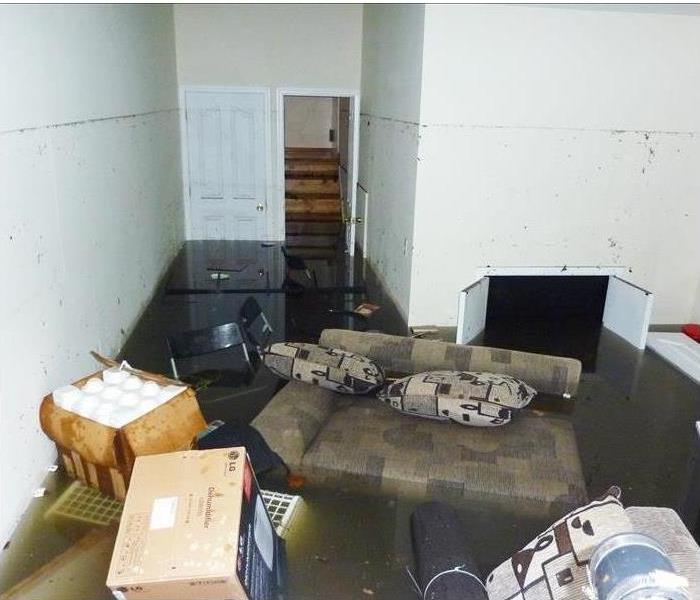 During any type of residential flood, there are professionals available to clean and restore your home
During any type of residential flood, there are professionals available to clean and restore your home
Finding flooded water in your basement is one of those events you hope to avoid during your lifetime. Water damage can be substantial and no Midtown Miami, FL, homeowner wants to pay for the associated repair and replacement costs. Fortunately, there are times when your homeowners' insurance covers water damage from a basement flood. Here is some information to help you determine if your flood may or may not be covered.
Sudden and Accidental Events Are Typically Covered
Many homeowners' policies will cover the expenses associated with water damage if the occurrence is sudden and accidental. Here are some examples of covered instances:
- A water heater rupture
- A pipe burst
- A break in an appliance supply hose
- Faulty plumbing
These are just some instances that are sudden and accidental. If you find water in your basement, contact your insurance company and explain the situation. Give your agent all the details and they will determine whether or not the incident is covered by your homeowners' insurance policy.
Gradual and Neglectful Events Are Typically Not Covered
A basement flood is typically not covered if the homeowner neglects to perform routine maintenance. One obvious example of when insurance coverage would not be in effect is a leaking faucet. Homeowners are responsible for maintaining their homes and associated appliances. While you can contact your insurance agent and explain the situation if it’s identified as poor maintenance on the part of the homeowner it most likely will not be covered.
It’s also helpful to understand that while some instances of flooding are covered by insurance, most insurance policies don’t cover the source of the problem. For example, insurance may cover the cost to repair damaged walls or flooring; however, it will not cover the cost to repair the broken washing machine.
Fortunately, during any type of basement flood, there are professionals available to clean and restore your home. Water restoration specialists are available to provide emergency service to homeowners.
Water Spreads Fast and far in Miami Condos
1/10/2021 (Permalink)
 SERVPRO Blowers in Residential Condo Hallway
SERVPRO Blowers in Residential Condo Hallway
When you have a water restoration emergency, we come prepared.
Most Condos have no water barriers in place in Midtown Miami
To remove water and restore average humidity from a residence after an accident, we use high-tech machines that locate, collect, and eliminate moisture. We never need to rely solely on visual evidence on your floors, walls, or ceilings. Many times, water accumulates on the inside of these structures in Wynwood Miami, FL, even though the exterior surface stays dry.
When a customer calls SERVPRO about leaky pipes that spilled water into their Midtown-Miami Condo, we assure them that we can handle the situation. Our training and equipment allow us to restore a healthy interior environment to their property using different water removal techniques. Achieving this is crucial when we want to prevent a house and its occupants from experiencing unnecessary ill effects. First, we must determine where your home has damp conditions.
What equipment do we use to locate water damaged areas in a property?
When you have SERVPRO cleanup water damage and dry out your home's structure after a broken pipe happens, our water removal technicians take images of seemingly dry structural surfaces. We do this with infrared cameras.
How does SERVPRO dry out a condo unit?
Our Team knows how to scale everything down to perfectly suit any size condo's needs. We address the two states of water:
- Liquid, as either standing water on horizontal surfaces or absorbed into permeable materials
- Vapor
With liquid water, we use pumps on our truck or handheld extractors to remove small quantities. This essential stage happens rather quickly. Water vapor can spread through your vents, hallways, and make its way throughout a home, including into enclosed cavities. Our desiccant and LGR dehumidifiers get rid of water vapor.
We monitor the situation during the project by taking readings and comparing these to the initial ones we obtained before we began working. Once finished, we take a final set of numbers and images to show that the interior is once again at normal moisture levels.
Many property owners know they can rely on SERVPRO of Wynwood to remove water after leaks and spills. Call (305) 377-2325. We can make everything, "Like it never even happened."
Water Loss Types
11/11/2019 (Permalink)
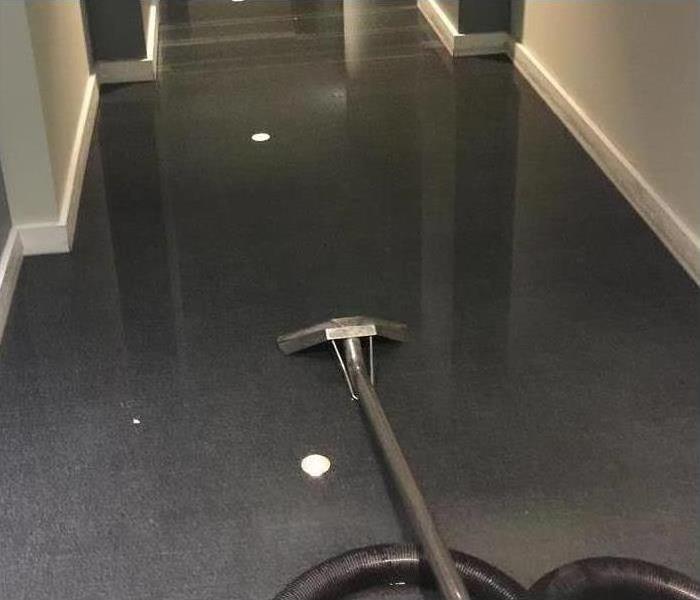 Water damage in a residential building.
Water damage in a residential building.
Water may seem very unlikely to cause damage. Do not be quick to dismiss it just yet. Water in the presence strong winds can be very destructive. It is for this reason that hurricanes and strong rains have claimed lives and destroyed millions worth of property. Water damage can also be as minimalist as broken water pipes that cause molding and rusting. These broken pipes are ranked second from hurricanes in causing water damage.
There are three types of water damage:
- Category 1 - This is does not cause any threat to human life. It is from is from broken house appliances and pipes which can flood a house or basement.
- Category 2 - This is also known "gray water". The water is contaminated and contains chemicals, micro-organisms, nutrients and biological contaminants. This water can cause serious health damage and discomfort when consumed.
- Category 3 - This is also known as "black water". This water is very unsanitary and contains harmful bacteria, fungi and harmful physical components like sharp tools. The source of this water is sewage, seawater, water rising from water bodies due to heavy rains and ground water.
Classes of water damage:
The several classes of water damage help in evaluating water control options.
- Class 1- Water damage is minimal, and the materials do not absorb a lot of water making repairs easy and less costly.
- Class 2- This class has a fast evaporation rate but other materials like cushions and mattresses may be damaged.
- Class 3- water has the fastest rate of evaporation here and the damage caused is greater and difficult to repair. The water may come from overhead sources and may soak the walls and furniture.
- Class 4- This stage requires professional technique and procedures to control. It may damage concrete and hard floors and plaster.
Spotting Water Damage
2/6/2019 (Permalink)
A house will be one of the biggest investments you will make in your lifetime. That’s why it is crucial to check the home for any kind of water damage before you move in. If left unattended, the water damage could spawn worse problems such as structural damage or maybe even mold. Here are some ways that to tell if your new home has water damage or not:
- Check Outside
Common signs of water damage are on the roof in pools of water, cracked or missing shingles.
- Look for Rust or Mold
Check your water heater and look for rust/damp spots anywhere on the floor. Mold is in any nook and crannies in your home. Use both sight and smell to find signs of mold.
- Check for Stains
Look for any unusual stains that could indicate that there is a leaky pipe or drain inside the wall. Cracks in the wall or soft and swollen areas are signs of trouble.
- Look at the Floors
For wood and tile floors look for cracked or warped flooring. With carpet look for damp spots, gradual rises, soft spots or the smell of mold and dampness.
Preventing Carpet Mold
1/23/2019 (Permalink)
If you’ve recently had a flood or a leak, no matter the size, it is a cause for concern for mold in the carpet. For mold, it doesn’t take much water for it to become harmful and spread, all it needs is a bit of moisture for it to grow. Mold can cause serious health issues such as respiratory problems, allergies, etc. Here are a few tips to prevent carpet mold after a flood or leak.
Act Fast
Act fast by drying it up as quickly as possible. Use fans to speed up the process as this will not only help the carpet dry, but also circulate the air in the room. Be aware that it can take a few days for the fans to dry the water damaged area, be sure to keep them running for 24 hours until the carpet is dry.
Invest in a Dehumidifier
Dehumidifiers are machines that will remove excess moisture in the room. They help make the air feel cooler and helps limit the growth of mold. The machine will help dry out the air and ground helping to speed up the dry time for your carpeted floors
Hire a Water Damage Cleanup Service
Companies that specialize in water damage cleanup can help get rid of the water fast. They have the tools and equipment needed to remove the water and help ensure mold and mildew don’t begin to spread. These services can help your carpets smell fresh again without any trace of the musky water damage odor.
Water Damage Prevention
1/22/2019 (Permalink)
Here at SERVPRO of Wynwood we are Water Damage specialists, and we compiled a small list on how to prevent water damage from happening often in your home:
- Clean Gutters and Downspouts - Clean your gutters at least twice a year to avoid blockage. Standing water can cause damage to your gutters and roof. Don’t forget to clean downspouts to ensure water can flow through, and secure downspouts so that they point away from the home.
- Know your Water Main - Know the location of your water main and shut it off if you leave for an extended amount of time.
- Check Appliances Regularly - Check and maintain your appliances regularly for leaks according to manufacturer’s directions.
- Investigate Leaks Right Away and Fix Promptly - If you choose to ignore any water damage, or postpone making the necessary repairs, be prepared to experience mold, mildew, dry rot, or even structural damage to your home.
- Upgrade Washing Machine Hoses - Old, brittle or leaky washing machine hoses are among the most frequent causes of water loss for homeowners. Replace yours often throughout the year to avoid an expensive damage.
- Check Your Water Pressure - If the water pressure to your home is too high, then your pipes and hoses may fail under the high pressure. Buy a water pressure gauge at a local hardware store, attach it to an outside faucet, and turn the faucet to full force. The gauge will give you a reading of the home’s water pressure. Typical homes water systems are designed for pressure of 40 – 70 psi. Anything above 70 psi will put your plumbing at risk.
- Monitor Your Water Bill - Sometimes, the only way you know that water is leaking is taking a closer look at your water bill. If your usage jumps significantly from one month to the next, then there is probably a leak somewhere in the home.
When a Mop Isn't Enough
1/7/2019 (Permalink)
SERVPRO of Wynwood is trained to safely clean and restore your customer's home, utilizing the following procedures:
- Identify the Source/Type of Water
- Measure Temperature and Humidity for Drying Analysis
- Survey the Extent of Damage and Inspect the Premises
- Perform Emergency Water Extraction
- Move and Block Furniture
- Provide Floor Service
- Inspect Carpet Pad/Carpet and Provide Service
- Apply Necessary Treatments
- Utilize Drying Equipment and Monitor Drying
- Dispose of Refuse
About SERVPRO of Wynwood
SERVPRO of Wynwood specializes in the cleanup and restoration of residential and commercial property after a fire, smoke or water damage event. Our staff is highly trained in property damage restoration. From initial and ongoing training at SERVPRO’s corporate training facility to regular IICRC-industry certification, rest assured our staff is equipped with the knowledge to restore your property.
For help restoring your home or business after a water loss, call SERVPRO of Wynwood at (305) 377-2325. We’ll make it “Like it never even happened.”
Service Response for a Water Damage
1/3/2019 (Permalink)
When there is a water intrusion, like a roof leak or leaking water line. We are water damage specialists who get started promptly to get your property dry and back. Our staff is highly trained in property water damage restoration. From initial and ongoing training at SERVPRO’s corporate training facility to regular IICRC-industry certification, rest assured our staff is equipped with the knowledge to restore your property after a water damage. With a nationwide system of qualified franchises, no water damage is too large or too small for SERVPRO of Wynwood. We are proud to serve our local surrounding communities upon request. If you would like to schedule service for your home or business, we are here to serve you 24/7, please call today 305-377-2325






 24/7 Emergency Service
24/7 Emergency Service







